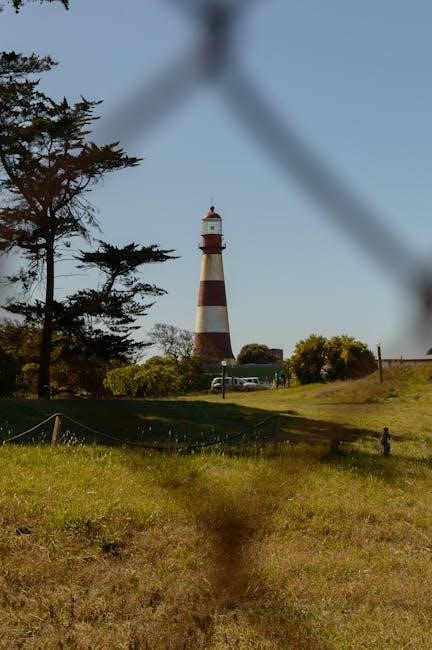field guide to monkeywrenching
Monkeywrenching is a radical environmental tactic involving direct action to disrupt industrial activities harming the planet. It combines sabotage‚ civil disobedience‚ and eco-activism to protect ecosystems and wildlife.
Definition and Key Principles
Monkeywrenching is a form of direct action environmentalism that involves sabotaging or disrupting activities deemed ecologically destructive. It is rooted in radical environmentalism‚ emphasizing nonviolent resistance to industrial practices harming nature. Key principles include targeting property rather than people‚ decentralization‚ and autonomous decision-making. Practitioners often view it as a necessary strategy to halt irreversible environmental damage when legal avenues fail. The philosophy underscores the moral obligation to protect ecosystems‚ challenging the dominance of human-centered exploitation. While controversial‚ monkeywrenching embodies a commitment to preserving biodiversity and ecological balance‚ reflecting a broader critique of industrial capitalism’s impact on the natural world.

History of Monkeywrenching
Monkeywrenching emerged in the late 20th century as a radical environmental response to industrial expansion‚ inspired by Edward Abbey’s 1975 novel The Monkey Wrench Gang.
Origins and Evolution of the Concept
Monkeywrenching traces its roots to the 1970s environmental movement‚ popularized by Edward Abbey’s 1975 novel The Monkey Wrench Gang‚ which advocated sabotage against industrial destruction of nature. The concept evolved from symbolic protests to direct action‚ gaining momentum in the 1980s with groups like EarthFirst! embracing it. Initially‚ tactics were simple‚ such as tree-spiking or equipment sabotage‚ but they became more sophisticated over time. The rise of digital tools expanded monkeywrenching to include cyber activism‚ targeting corporations and governments online. Today‚ it remains a controversial yet influential strategy in environmental activism‚ blending traditional and modern methods to challenge ecological destruction.

Ethical Considerations
Monkeywrenching raises ethical dilemmas‚ balancing environmental protection against potential harm to humans and property. Critics argue it risks lives and undermines legal processes‚ while supporters see it as a necessary last resort to safeguard ecosystems.
Moral Arguments For and Against Monkeywrenching
Proponents argue monkeywrenching is morally justifiable as a defense of nature‚ emphasizing its effectiveness in halting environmental destruction. They liken it to civil disobedience‚ where breaking laws upholds a higher moral code; Critics‚ however‚ contend that intentional property damage and potential harm to humans violate ethical principles. They emphasize the importance of nonviolent protest and legal avenues for change. Additionally‚ opponents highlight the risk of alienating public support‚ undermining the environmental movement’s credibility. The moral debate centers on whether ends justify means and the balance between environmental preservation and societal norms. This ethical tension remains central to discussions on radical activism.

Direct Action Tactics
Monkeywrenching employs direct action tactics like blockades‚ tree-sitting‚ and equipment sabotage to disrupt industrial activities. These methods aim to halt environmental destruction through nonviolent or confrontational means.
Blocking Access to Industrial Sites
Blocking access to industrial sites is a cornerstone tactic in monkeywrenching‚ aiming to disrupt harmful activities like logging‚ mining‚ or construction. Activists often use physical barriers‚ such as barricades‚ locked gates‚ or even their own bodies‚ to prevent workers and machinery from entering the site. Tree-sitting‚ where individuals occupy trees slated for cutting‚ is another common method. These actions are designed to halt operations temporarily‚ giving ecosystems a reprieve and drawing attention to environmental causes. While nonviolent‚ these tactics can escalate tensions with authorities and industries; The goal is to create economic pressure and public awareness‚ forcing policymakers to reconsider destructive practices. This direct approach reflects the urgency felt by environmental advocates.
Vandalism and Property Damage
Vandalism and property damage are controversial tactics within monkeywrenching‚ involving intentional destruction of industrial equipment or infrastructure to halt environmentally harmful activities. Activists may use methods like cutting power lines‚ disabling machinery‚ or applying “eco-sabotage” techniques such as pouring sand into engines or using tree spikes to damage logging equipment. These actions aim to create economic losses and disrupt operations‚ forcing industries to reconsider their practices. While proponents argue such tactics are necessary to protect ecosystems‚ critics highlight the legal and ethical risks‚ as well as potential backlash. Vandalism often escalates conflicts‚ making it a divisive yet impactful strategy in environmental activism.

Sabotage Methods
Sabotage methods in monkeywrenching involve intentional acts to disrupt or disable industrial operations. Common techniques include tampering with machinery‚ disabling vehicles‚ and using tools like spike bars or caltrops. Advanced methods may involve cyber sabotage or chemical interference. These actions require careful planning and precision to maximize impact while minimizing risks. Sabotage is often seen as a direct way to halt environmentally destructive practices‚ though it carries significant legal and ethical implications. It remains a controversial yet powerful tactic in the toolkit of radical environmentalism.
Industrial Sabotage Techniques
Industrial sabotage techniques in monkeywrenching focus on disabling machinery and infrastructure critical to destructive operations. Common methods include damaging heavy equipment‚ severing power lines‚ or tampering with industrial controls. Activists often use tools like spike bars to puncture tires or chains to block access roads. In some cases‚ digital sabotage involves disrupting industrial systems remotely. These actions aim to halt operations temporarily or permanently‚ often targeting logging‚ mining‚ or construction sites. Sabotage requires meticulous planning to avoid detection and ensure safety. While effective‚ these methods carry significant legal risks and ethical debates‚ as they balance environmental protection against property damage and potential harm to workers.
Digital Sabotage and Cyber Activism
Digital sabotage and cyber activism are modern extensions of monkeywrenching‚ targeting industrial operations through online disruption. Tactics include hacking‚ data breaches‚ and DDoS attacks to disable websites or systems. Activists often target industries like logging or mining‚ aiming to disrupt supply chains or expose unethical practices. Cyber campaigns may also involve leaking sensitive information to harm corporate reputations. Tools like VPNs and encrypted communication help maintain anonymity. While these methods avoid physical harm‚ they still carry legal risks and ethical debates. Digital sabotage has become a powerful tool in environmental activism‚ offering a new frontier for disrupting destructive practices and raising global awareness of ecological issues.

Legal Consequences
Monkeywrenching often results in criminal charges‚ including vandalism‚ trespassing‚ and property damage; Activists may face fines‚ imprisonment‚ and civil lawsuits for damages or lost revenue.
Criminal Charges and Penalties
Monkeywrenching activities often lead to criminal charges‚ including vandalism‚ trespassing‚ and property damage. These offenses can result in significant fines‚ imprisonment‚ and lengthy legal battles. In severe cases‚ charges may escalate to felony-level offenses‚ carrying penalties of several years in prison. Law enforcement agencies and courts typically treat such actions as serious crimes due to their potential to disrupt public safety and economic operations. Additionally‚ those convicted may face long-term consequences‚ such as difficulty finding employment and a permanent criminal record. The legal system’s response underscores the high risks involved in engaging in monkeywrenching tactics.
Civil Liability and Lawsuits
Individuals or organizations engaging in monkeywrenching often face civil lawsuits for damages caused by their actions. Property owners or corporations targeted by sabotage can seek financial compensation for losses‚ including property damage‚ lost revenue‚ or operational disruptions. Courts may hold activists liable for these costs‚ even if criminal charges are not pursued. Civil cases often rely on evidence of intentional interference or negligence‚ and plaintiffs may pursue class-action lawsuits if multiple parties are affected. Legal strategies may include seeking injunctions to prevent future actions or claiming restitution for harm caused. Civil liability adds another layer of risk for those involved in monkeywrenching‚ as financial penalties can be substantial.

Environmental Impact
Monkeywrenching aims to halt ecological destruction but often sparks debates about its unintended consequences‚ such as potential harm to non-target species or ecosystems during sabotage actions.
Assessing the Effectiveness of Monkeywrenching
Evaluating monkeywrenching’s success is complex. While it can halt or delay industrial projects‚ long-term environmental benefits are debated. Some actions draw attention to ecological issues‚ sparking public awareness and policy changes. However‚ sabotage often leads to increased security measures and legal crackdowns‚ potentially undermining broader environmental movements; The tactic’s effectiveness depends on strategic planning‚ public support‚ and the balance between immediate environmental protection and the risks of alienating allies. Ultimately‚ its impact varies widely‚ making it a controversial yet enduring strategy in radical environmentalism.

Case Studies
Notable examples include EarthFirst!’s tree-spiking campaigns and Sea Shepherd’s anti-whaling missions‚ showcasing the tactic’s controversial yet impactful role in environmental activism.
Notable Examples of Successful Monkeywrenching Actions
Historically‚ monkeywrenching has been used effectively by environmental groups to halt destructive practices. EarthFirst! famously employed tree-spiking to prevent logging‚ while Sea Shepherd disrupted whaling operations. The Edward Abbey-inspired tactic gained prominence through actions like disabling machinery and blocking access to industrial sites. These actions‚ though often illegal‚ drew attention to critical environmental issues. For instance‚ sabotage of logging equipment in old-growth forests saved countless trees‚ while road blockades delayed mining projects. Such acts‚ though controversial‚ demonstrated the power of direct action in environmental activism‚ inspiring further movements and highlighting the lengths some are willing to go to protect ecosystems and wildlife;

Philosophy Behind Monkeywrenching
Monkeywrenching is rooted in deep ecology‚ emphasizing Earth’s intrinsic value. It advocates radical action to protect ecosystems‚ prioritizing nature over human exploitation‚ embodying a fierce environmental ethos.
Deep Ecology and Radical Environmentalism
Deep ecology is a philosophical framework that views Earth as an intricate‚ interconnected system with inherent value. It rejects anthropocentrism‚ advocating for the rights of all species and ecosystems. Radical environmentalism extends this philosophy into action‚ often through direct and controversial methods like monkeywrenching. This approach prioritizes ecological preservation over economic or human interests‚ embracing civil disobedience to challenge industrial destruction. Influenced by thinkers like Arne Naess and Edward Abbey‚ radical environmentalists argue that drastic measures are necessary to halt ecological collapse. While supporters see it as a moral imperative‚ critics label it as extremism‚ sparking debates on ethics and effectiveness in environmental activism.

Cultural Significance
Monkeywrenching has influenced literature‚ film‚ and activism‚ symbolizing resistance against environmental destruction. Its portrayal in media highlights its controversial yet impactful role in shaping radical environmental movements.
Monkeywrenching in Media and Popular Culture
Monkeywrenching has gained significant attention in literature‚ films‚ and documentaries‚ often portrayed as a radical yet necessary response to environmental destruction. Books like The Monkey Wrench Gang by Edward Abbey have popularized the concept‚ while films and series depicting ecological activism frequently reference such tactics. The movement’s controversial nature makes it a compelling narrative‚ often highlighting the tension between law enforcement and environmentalists. Social media platforms amplify these stories‚ fostering debates and inspiring new generations of activists. This cultural presence underscores monkeywrenching’s role in shaping public perception of environmental activism‚ blending fiction with real-world resistance.
Monkeywrenching remains a controversial yet impactful strategy in environmental activism‚ blending radical action with ethical debate. Its future hinges on balancing direct resistance with legal and societal acceptance.
Future of Monkeywrenching in Environmental Activism
The future of monkeywrenching lies in its ability to adapt to modern environmental challenges while addressing ethical and legal concerns. As climate change intensifies‚ radical tactics may gain traction among activists seeking immediate action. However‚ the movement must navigate stricter laws and public scrutiny. Digital sabotage and cyber activism could emerge as key strategies‚ blending traditional methods with technological advancements. Collaboration with mainstream environmental groups might enhance its legitimacy‚ though the core philosophy of direct action is unlikely to change. Balancing effectiveness with accountability will be crucial for monkeywrenching to remain a viable force in environmental activism.

